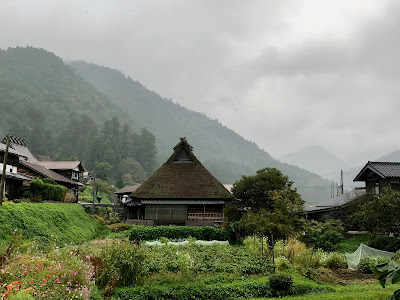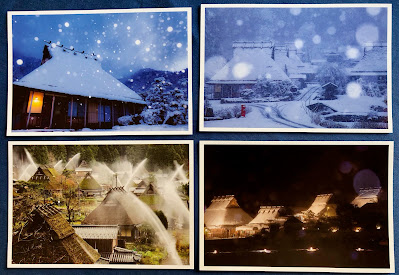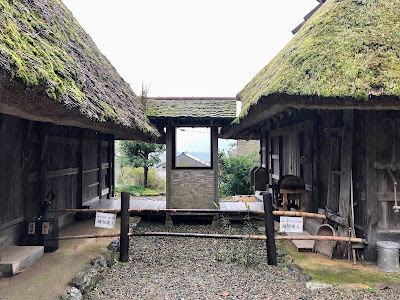 |
| 関西旅行 神戸・美山 : 2022年10月16日~19日 このセクションは、主に京都府 美山 (ミヤマ) : ★ についてです。 Kansai Trip Kobe・Miyama: 16th ~ 19th of October, 2022 This section is mainly about Miyama in Kyoto. ★ : Miyama Guide in English |
目次 / Contents
1) 美山町 / Miyama Town
A. 南丹市 / Nantan City
B. かやぶきの里 / Miyama's Thatched Village
2) 散策 - 前半 / Walk - First Half
A. 霧と雲の間 / Between the Mist and the Clouds
B. お地蔵様 / Jizo Statue
C. かやぶきと植物 / Thatch and Plants
D. 火の用心 / Fire Prevention
E. 美山民俗資料館 / Miyama Folk Museum
3) カフェ美卵 / Cafe Milan
1) 美山町 / Miyama Town
A. 南丹市 / Nantan City
美山町は京都府 北桑田郡 (キョウトフ キタクワダグン) に含まれていました。
合併し南丹市になりました。
美山町には複数の観光地があります。
友人Mと友人Izuと私は、美山の 'かやぶきの里' に行きました。
私達は英国留学中に知り合い、ずっと友達づき合いをしています。
2022年10月、Mは大阪在住、Izuは北海道在住、私は神奈川在住です。
とても久しぶりに3人で旅行する機会を得ました。
この日帰り旅行は、Mが主に企画し、車も彼女が出してくれ、運転もしてくれました。
私は彼女に紹介されるまで、'美山'も'かやぶきの里'も知りませんでした。
M、どうもありがとう!
 |
| 赤い部分 : 京都府 Red Part : Kyoto Prefecture 画像は下記より / This from below ★ |
 |
| 濃いピンク部分 : 南丹市 Deep Pink Part : Nantan City 画像は下記より / This from below ★ |
Nantan City
Miyama Town was part of Kitakuwada Gun (District) Kyoto Prefecture.
In 2006, Miyama, along with the towns of Hiyoshi, Sonobe,
and Yagi (all from Funai District), was merged to create Nantan City.
There are several tourist spots in Miyama.
My friends M, Izu and I went to 'Miyama's Thatched Village (Kayabuki-no-Sato)'.
We met while studying abroad in the UK and have remained friends ever since.
As of October 2022, M lives in Osaka, Izu lives in Hokkaido, and I live in Kanagawa.
We had the opportunity to travel together for the first time in a long time.
M was the one who organized this day trip, provided the car and drove as well.
I had never heard of 'Miyama' or ''Miyama's Thatched Village' until she introduced them to me.
Thank you, M!
 |
| 赤い楕円枠 : 美山町 Red oval frame : Miyama Town 画像は下記より / This from below ★ |
 |
| 美山 / Miyama 画像は下記より/ This from below ★ |
B. かやぶきの里
Miyama's Thatched Village
 |
| うぐいす色部分 : 美山町 黄緑部分 : 京都府 Light Green Part : Miyama Town Yellow Green Part : Kyoto Prefecture 画像は下記より/ This from below ★ |
美山町の北集落は茅葺き民家が多く残っており、'かやぶきの里' と
呼ばれています。
この集落は、国の重要伝統的建造物群保存地区として選定されています。
下記、Wikiより
"この村は50戸ほどの集落であるが、うち交流館、民俗資料館、民宿なども含めた38戸が茅葺き屋根である。"
同じような集落として、白川郷 (シラカワゴウ) が思い出されます。
白川郷 は、山深い場所にありますが、こちらは開けた印象を持ちます。
白川郷については下記。
↓
多くの旅人が行き来し、各地の文化・建築技術などがこの集落に影響をもたらしたようです。
茅葺きと藁葺きの屋根がありますが、通常私は、藁葺き屋根として認識していました。
藁葺き屋根に対する強い印象は、『三匹の子豚』で私に刷り込まれたように思います(笑)。
"人の茅の利用の歴史は古く、茅が水分に強いことは古くから知られていたと考えられている。
屋根材では茅に比べると藁は油分が少なく耐水性に劣るとされている。
しかし、茅よりも藁のほうが入手しやすく、民俗例では茅葺き屋根であっても最下層の下地には藁を用いていることが多い。"
 |
| 画像は下記より/ This from below ★ |
Miyama's Thatched Village
The northern settlement of Miyama Town has many thatched roof houses remaining, and is known as 'Miyama's Thatched Village (Kayabuki-no-Sato)'.
This settlement has been designated as one of the Preservation Districts for Groups of Historic Buildings.
According to Japanese Wiki about 'Miyama's Thatched Village'
"This village has about 50 houses, of which 38, including the community center, folk museum, and guesthouse, have thatched roofs."
A similar settlement comes to mind Shirakawa-go (Historic Villages of Shirakawa-gō and Gokayama ).
About Shirakawa-go, below.
Shirakawa-go is located deep in the mountains, while this settlement has an open feel.
This is halfway between Kyoto and Wakasa, and the road that passed through the settlement was one of the Mackerel Roadways (Saba-Kaido).
It seems that many travelers passed through the area, and the culture and architectural techniques of each region influenced the settlement.
There are thatched and straw roofs, but I usually think of them as straw roofs.
I found how they differ from Japanese Wiki : Thatched Roofing,
see below. (Translated by me)
"The history of humans using thatch is long, and it is believed that the moisture resistance of thatch has been known since ancient times.
As a roofing material, straw is said to have less oil than thatch and is less water-resistant.
However, straw is easier to obtain than thatch, and in folk examples, straw is often used for the base of the bottom layer even in thatched roofs."
 |
| 赤い線 : 鯖街道 下記、Wiki: 鯖街道より "主に魚介類を京都へ運搬するための物流ルートであったが、 最も割合が高かったのが鯖であったことから、 鯖街道と呼ばれるようになった" Red Lines : Mackerel Roadways (Saba-Kaido) According to Japanese Wiki about the Roads (Translated by me) "They were logistics routes mainly for transporting seafood to Kyoto, and the largest proportion of the fish was Mackerel, so they came to be called the Mackerel Roadways (Saba-Kaido)." 画像は下記より / This from below ★ |
2) 散策 - 前半 / Walk - First Half
A. 霧と雲の間
Between the Mist and the Clouds
私達が美山を訪れた日は、曇り時々雨という天気でした。
駐車場から見た、'かやぶきの里' は霧がおり、タイムスリップしたような風景に見えました。
傘を片手に撮影することも多く、撮影が面倒に感じつつも、何枚も
何枚も撮影してしまいました。
写真の順序は、私達が歩んだ道なりに沿っていますが、時々テーマ別に項目をまとめていて、それは実際の歩いて見た順番(撮影の順番)と前後しています。
Between the Mist and the Clouds
The day we visited Miyama, it was cloudy with occasional rain.
Viewed from a carpark, 'Miyama's Thatched Village (Kayabuki-no-Sato)' was shrouded in mist, making it look like a scene from a time warp.
I often had to take photos with an umbrella in hand, and even though
it felt like a hassle, I ended up taking many photos.
Some of these photos are grouped thematically, which may differ from the order in which we actually walked (and took the photos).
雨の音と一緒に/ With the Sound of Rain
 |
| 地図 / Map |
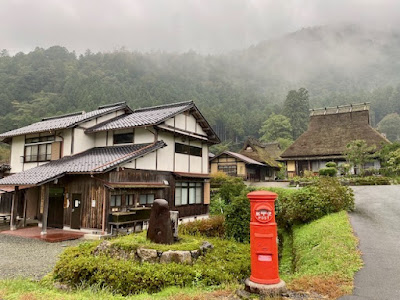 |
| 集落入り口? 周囲が自然の色ばかりの中で、赤いポストが印象的です。 左の建物は、公民館です。 The Village Entrance? The red postbox stands out amongst the natural colours surrounding it. The building on the left is the community centre. |
B. お地蔵様 / Jizo Statue
 |
| お地蔵様 (Ojizō-sama) 鯖街道沿いにお地蔵様があります。 Kṣitigarbha : Jizo Bodhisattva This Jizo statue is on one of the Mackerel Roadways (Saba-Kaido). According to Wiki about Jizo "In Japan, Kṣitigarbha's statues (Jizo statues) are often adorned with bibs, kerchiefs or kasa hat on his head, and sometimes dressed with a haori. " |
お地蔵様を見るたびに、悲しい気持ちがふっと湧き起こります。
それは、幼くして亡くなった子供達、そして、その子供達にまつわる日本の伝承によるものかと考えます。
そこへ地蔵菩薩が出向き、鬼から子供達を守り、仏法や経文を聞かせて徳を与え、成仏への道を開いていく(成仏する)というのが日本の伝承にある。"
参照(Wiki; 地蔵菩薩 / Wiki 賽の河原 / Wiki ; 日本における地蔵信仰)
最終的には、地蔵菩薩により、子供達が救われることを知り、ほっとしました。
Jizo Statue
Every time I see a Jizo statue, a feeling of sadness suddenly wells up inside me.
I think it may be due to the children who died at a young age and the Japanese folklore surrounding those children.
"When young children die before their parents, they cannot cross the Sanzu River because they have caused their parents sadness and have not accumulated any merit for filial piety.
Instead, they suffer at Sai no Kawara as punishment for their unfilial deeds.
It is said that the children can make a cairn at Sai no Kawara to memorialize their parents which becomes filial piety, but before it is completed, a demon will come and destroy the tower, and even if they build the tower again and again, the same thing will happen again.
In Japanese legend, Jizo Bodhisattva appears there, protects the children from demons, gives them virtue by reciting Buddhist teachings and sutras, and the children attain nirvana."
Reference :
During this search, I found for the first time "Sainokawara Jizo Wasan:"西院河原地蔵和讃" →★; Lyrics in Japanese)" and learned that the story was far more tragic than the one I had known.
I felt relieved when I found that in the end, the children were saved by Jizo Bodhisattva.

C. かやぶきと植物 / Thatch and Plants
 |
| 左下、緑の物体はコンポストでしょうか? Is the green object on the bottom left for compost? |
 |
| 交流館 Koryu-kan : Cultural Exchange Hall |
 |
'山崎昌伸詩画集展' 山崎 昌伸 : ★氏の詩画集の展覧会が、交流館で開催されて いたのかもしれません。 私達には時間があまりなかったので、行きませんでした。 山崎氏は、"2006年から季節の移ろいをモチーフに 詩画作家として京都美山を拠点に全国百貨店にて 活動しています。" 'Poetry and Pictures Collection of Yamazaki Masanobu Exhibition' Yamazaki Masanobu : ★ an exhibition of his poetry and art collection may have been held at the Cultural Exchange Hall. We didn't have much time, so we didn't go. Yamazaki is "a poet and painter who has been active in department stores nationwide since 2006, with the 'changing of the seasons' as his motif, based in Miyama, Kyoto." |
晴れの日は、晴れの日で美しい景色が広がっているとは思います。
ですが、この日は、この日で、神秘的で、素晴らしかったです。
I'm sure that on sunny days the scenery is beautiful.
But today, our day was magical and wonderful.
 |
| 民宿 久や(ヒサヤ) : ★ / ★ この看板によって、集落に民宿があることを知りました。 Minshuku Hisaya : ★ / ★ only in Japanese This sign told me that there is a guesthouse : Minnshuku in the village. |
 |
民宿 久や 〒601-0712 南丹市美山町北中牧5 築150年以上の「かやぶき民家」の民宿 1組限定(一棟貸し) Minshuku Hisaya 5 Kitanakamaki, Miyama-cho, Nantan City, 601-0712 A thatched-roofed guesthouse built over 150 years ago Limited to one group at a time, (whole house rental). |
D.火の用心 / Fire Prevention
 |
| 放水 / Water Discharge 画像は下記より/ This from below ★ |
E. 美山民俗資料館 / Miyama Folk Museum
 |
| Miyama Folk Museum Sign Pole |
 |
| 美山民俗資料館 ここは見てみたいとおもったのですが、休館でした。 Miyama Folk Museum I wanted to enter, but today was their holiday. |
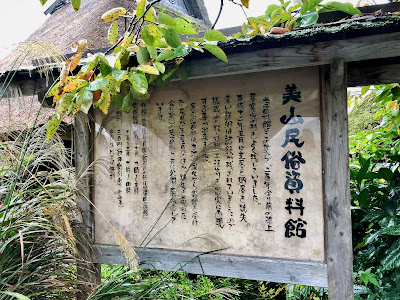 |
| 美山民俗資料館 : ★ 築約200年のかやぶき民家が資料館となっていましたが 2000年に全焼、2002年に復元され、再び資料館になりました。 先に記載した放水銃の格納箱は、この火災をきっかけに、 62基の放水銃が設置されました(★)。 Miyama Folk Museum: ★ only in Japanese The museum was housed in a thatched roof house built about 200 years ago, but it burned down in 2000 and was restored in 2002, once again serving as a museum. This fire was the trigger for the installation of 62 water cannons, as mentioned earlier (★ only in Japanese). |
 |
| 屋根の裏 (軒下部分) Under the Roof (Part of under the eaves) |
 |
| 屋根の底辺 (軒下部分) Lowest Part of Roof |
3) カフェ美卵 / Cafe Milan
 |
| カフェ美卵 / Cafe Milan : ★ |
 |
| 一休み 美山牛乳ジェラートはこのカフェの人気品目です。 注文したのは、Mでしたか?Izuでしたか? Take a Break Miyama milk gelato is a popular item in this cafe. Who ordered, M or Izu? |
 |
| 展示のポストカードを撮影しました。 (許可は得ています) I took photographs of postcards from the exhibition. (Permission obtained)    |
 |
| カフェ・ミランの袋 ポストカードを数枚購入しました。 Cafe Milan Bag I bought a few postcards from Cafe Milan. |
 |
| Izu が私を撮影してくれました。 Izu took this photo of me. |
 |
| Izu がMと私を撮影してくれました。 Izu took this photo of M and me. |








